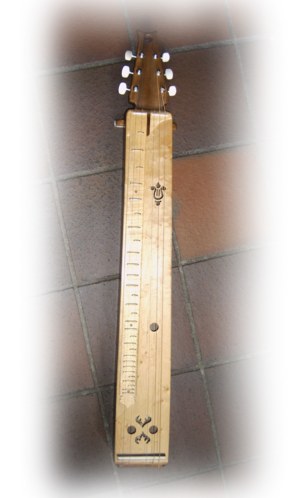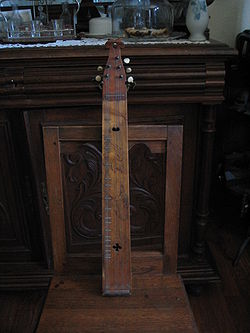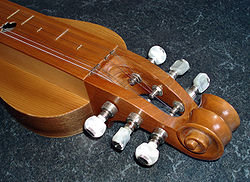
Epinette des Vosges
Encyclopedia

Zither
The zither is a musical string instrument, most commonly found in Slovenia, Austria, Hungary citera, northwestern Croatia, the southern regions of Germany, alpine Europe and East Asian cultures, including China...
family, whose use was confined to two areas in the Vosges mountains
Vosges mountains
For the department of France of the same name, see Vosges.The Vosges are a range of low mountains in eastern France, near its border with Germany. They extend along the west side of the Rhine valley in a northnortheast direction, mainly from Belfort to Saverne...
of France approximately 50 km apart: around Val-d'Ajol and around Gérardmer
Gérardmer
Gérardmer is a commune in the Vosges department in Lorraine in northeastern France.-Culture:The Fantastic'Arts festival of horror and fantastic film has been held in Gérardmer each year since 1994.-External links:...
.
Origins
The épinette has been attested as early as the 18th century in the Val-d'Ajol and Plombières-les-BainsPlombières-les-Bains
Plombières-les-Bains is a commune in the Vosges department in Lorraine in northeastern France.Les bains refers to the hot springs in the area, whose properties were first discovered by the Romans...
regions of southern Vosges
Vosges
Vosges is a French department, named after the local mountain range. It contains the hometown of Joan of Arc, Domrémy.-History:The Vosges department is one of the original 83 departments of France, created on February 9, 1790 during the French Revolution. It was made of territories that had been...
, whence comes its name. The earlier origins of the épinette des Vosges remain unknown, though some believe the instrument was introduced by the Swedes during the Thirty Years' War
Thirty Years' War
The Thirty Years' War was fought primarily in what is now Germany, and at various points involved most countries in Europe. It was one of the most destructive conflicts in European history....
. It is, however, also possible that it is descended from the medieval psaltery
Psaltery
A psaltery is a stringed musical instrument of the harp or the zither family. The psaltery of Ancient Greece dates from at least 2800 BC, when it was a harp-like instrument...
.

Types of epinette and geographical areas
Instruments of this family, formerly widespread throughout Europe, are now primarily found in Norway (the langeleikLangeleik
The langeleik also called langleik is a Norwegian stringed folklore musical instrument, a droned zither.-Description:The langeleik has only one melody string and up to 8 drone strings....
), Iceland (the langspil
Langspil
The Langspil is a traditional Icelandic drone zither. Since old folk music has been gaining more popularity in recent years, more and more people are able to play this instrument...
), Flanders (the hummel
Hummel (instrument)
The hummel is an old Swedish stringed instrument similar to an older type of zither and is related to the Norwegian langeleik. The name is thought to come from the German word hummel, meaning "bumblebee", referring to the droning sound created by the accompaniment strings.-History:The hummel is...
), Hungary, as well as France. A parallel instrument, the Appalachian dulcimer
Appalachian dulcimer
The Appalachian dulcimer is a fretted string instrument of the zither family, typically with three or four strings. It is native to the Appalachian region of the United States...
is found in rural mountain areas of the Eastern United States.
The Val-d'Ajol épinette
This instrument is first attested in accounts dated 1730. The primitive version with four strings evolved into a five-string model. The Val-d'Ajol épinette is of small size, between 50 and 60 cm, in the form of a parallelogram with a wide base. The frets, originally numbering fourteen, increased to seventeen in the 19th century. The fretting is diatonic, tuned to open C majorC major
C major is a musical major scale based on C, with pitches C, D, E, F, G, A, and B. Its key signature has no flats/sharps.Its relative minor is A minor, and its parallel minor is C minor....
. It is fretted with the fingers of the left hand, or alternately with a small piece of smooth wood. The right hand strums with the thumb, a goose quill, or a pick.
The most prolific épinette luthier was Amé Lambert (1843–1908), who manufactured up to 500 épinettes per year.
The Gérardmer épinette
This instrument was first attested in 1723. It is a simple instrument built by luthiers, or by the musicians themselves. The instrument fell out of vogue, and little is known about it until it was revived after 1945.The épinettes of Upper Vosges are large, approximately 80 cm. The number of strings varies from three to eight, with diatonic fretting.
Playing techniques
The épinette is diatonic, producing a heptatonic major scale. The number of frets increased from fourteen to seventeen during the 19th century, giving it a range of two and a half octaves.- Right-hand techniques:
- Strumming back and forth across all the strings (melody and drone) or just the doubled melody strings with the pick, goose feather, or thumb. This is the traditional manner.
- Fingerpicking, as with a guitar, using all but the little right finger to pluck the strings.
- Striking the strings with a small stick (like a fretted hammered dulcimerHammered dulcimerThe hammered dulcimer is a stringed musical instrument with the strings stretched over a trapezoidal sounding board. Typically, the hammered dulcimer is set on a stand, at an angle, before the musician, who holds small mallet hammers in each hand to strike the strings...
- Using a violin or bowed psalteryBowed psalteryA bowed psaltery is a psaltery that is played with a bow.-Violin Zither:In 1925 a German patent was issued to the Clemens Neuber Company for a bowed psaltery which also included a set of strings arranged in chords, so that one could play the melody on the bowed psaltery strings, and strum...
bow.
- Left-hand techniques:
- Fretting the strings with a smooth stick or reed, called a "noteur" (noter). This gives the music a sliding metallic sound with pronounced glissandoGlissandoIn music, a glissando is a glide from one pitch to another. It is an Italianized musical term derived from the French glisser, to glide. In some contexts it is distinguished from the continuous portamento...
. - Fretting the strings with the first three fingers, or all five for more complex pieces or on chromatic instruments. This technique is less traditional but well-suited to playing more complex melodies.
- Fretting the strings with a smooth stick or reed, called a "noteur" (noter). This gives the music a sliding metallic sound with pronounced glissando
An épinette player usually plays sitting down. The épinette is placed on a table (most often), or on the lap angling away from the player. Unlike other forms of dulcimer, the épinette gives some separation between the melody strings and the drones. Thus, those areas can be struck separately to establish rhythm.
The instrument is tuned by ear rather than to concert pitch, and may be tuned higher or lower depending on the accompanying instrument, the épinette's individual sound, or personal taste.
In addition to the diatonic épinette, there are epinettes with added frets for each semi-tone, in order to compose the chromatic scale. On a chromatic épinette, one can play in any key without re-tuning.
The modes

The possible modes are:
| Mode | Départ de la main gauche | Accord du 1st string | 2nd string | 3rd string |
|---|---|---|---|---|
| DO | Chanterelles jouant à vide | SOL | DO | DO ou SOL |
| RE | 1st case | LA | RA | LA ou RE |
| MI | 2nd case | SI | MI | SI ou MI |
| FA 1st façon | 3rd case | DO | FA | DO or FA |
| FA 2nd façon | 6th case | FA | DO | DO or FA |
| SOL | Chanterelles jouant à vide | SOL | RE | SOL or RE |
| LA | 1st case | LA | MI | LA or MI |
| SI | 2nd case | SI | FA | SI or FA |
Epinette players
- Jean-François DutertreJean-François DutertreJean-François Dutertre is a French singer-songwriter and player of the hurdy-gurdy, épinette des Vosges, and traditional French music. He also plays the bodhran and the bouzouki....
- Jean-Loup Baly
- Christophe Toussaint
- Patrice Gilbert
- Jacques Leininger
Contemporary makers
- Christophe Toussaint, Dommartin-lès-RemiremontDommartin-lès-RemiremontDommartin-lès-Remiremont is a commune in the Vosges department in Lorraine in northeastern France.-External links:*...
- Jean-Claude Condi, MirecourtMirecourtMirecourt is a commune in the Vosges department in Lorraine in northeastern France. Mirecourt is known for lace-making and the manufacture of musical instruments, particularly those of the violin family...
Discography
- Jean-François Dutertre La ronde des Milloraines
- Jean-François Dutertre Si l'amour prenait racine
- Jean-François Dutertre L'épinette des Vosges
- Christophe Toussaint Terra Incognita
- Association de l'épinette des Vosges, Plombières-les-BainsPlombières-les-BainsPlombières-les-Bains is a commune in the Vosges department in Lorraine in northeastern France.Les bains refers to the hot springs in the area, whose properties were first discovered by the Romans...
A la découverte de l'épinette des Vosges - Association de l'épinette des Vosges, Plombières-les-BainsPlombières-les-BainsPlombières-les-Bains is a commune in the Vosges department in Lorraine in northeastern France.Les bains refers to the hot springs in the area, whose properties were first discovered by the Romans...
Trois dames à table
External links
- Épinette des Vosges
- Site de Christophe Toussaint, avec sons
- Site de Michael J King, Luthier
- Rencontres internationales de Saint Chartier
See also
- Appalachian dulcimerAppalachian dulcimerThe Appalachian dulcimer is a fretted string instrument of the zither family, typically with three or four strings. It is native to the Appalachian region of the United States...
- Hummel (instrument)Hummel (instrument)The hummel is an old Swedish stringed instrument similar to an older type of zither and is related to the Norwegian langeleik. The name is thought to come from the German word hummel, meaning "bumblebee", referring to the droning sound created by the accompaniment strings.-History:The hummel is...
- LangeleikLangeleikThe langeleik also called langleik is a Norwegian stringed folklore musical instrument, a droned zither.-Description:The langeleik has only one melody string and up to 8 drone strings....
- LangspilLangspilThe Langspil is a traditional Icelandic drone zither. Since old folk music has been gaining more popularity in recent years, more and more people are able to play this instrument...
- ScheitholtScheitholtThe scheitholt or scheitholz is a traditional German stringed instrument and an ancestor of the modern zither. It falls into the category of drone zithers.-History:...

